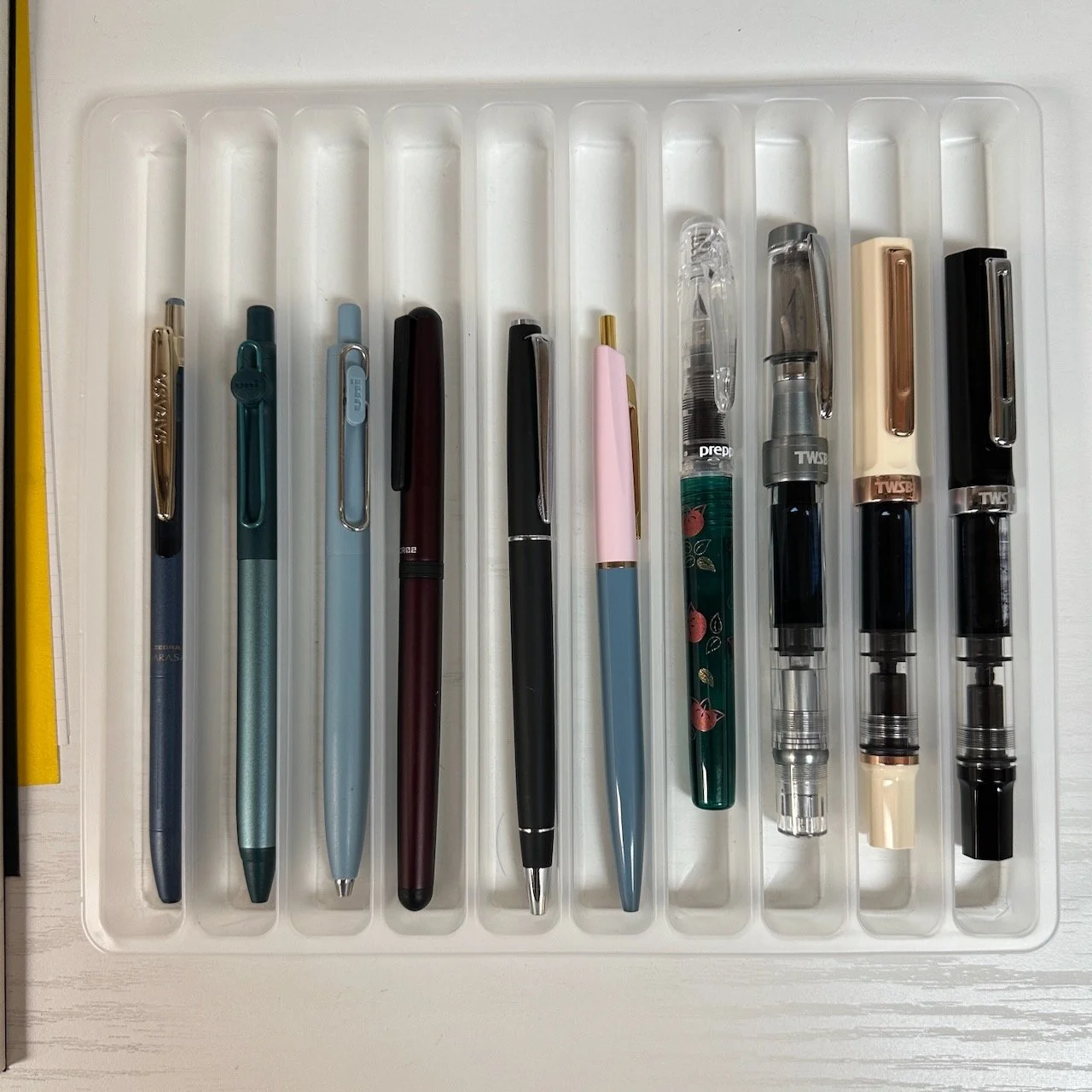We’ve had a lot of new pen enthusiasts discover our brick-and-mortar shop recently, including many who have never held, much less used, a fountain pen! As someone heavily invested in the growth of this community, it’s always incredibly gratifying to meet new users, especially when they leave with their first pen. But “Where do I start?” can be a difficult question to answer. Here’s my typical process, and I thought it might be fun to give you a behind-the-scenes look.
Start at the Testing Station. We have a testing station set up in-store (see pic at top) so that customers can write with a rotating selection of certain pens that we offer. As of now, the fountain pen part of the tray contains four pens: a Platinum Preppy with a fine nib, two TWSBI ECO fountain pens with a medium and broad nib, and a TWSBI Diamond 580 with a stub. I always ask the customer to write a few lines on Maruman Mnemosyne paper with the medium TWSBI nib, from which we can either go finer or broader depending on preference. I find that a TWSBI Medium serves as a nice baseline for determining preferences, so there’s usually always one of those inked up and on hand.
Don’t go too expensive for a first fountain pen. I hesitate to venture too far outside the $20-40 price range for a first pen, and usually have an even less expensive option (here, the Preppy Wa) just to show that it’s possible to find a reliable everyday writer at a relatively inexpensive price point. Spending too much can lead to frustration with the inevitable learning curve, and I want people to feel free to take their new pen everywhere and write with it as much as they can without being overly afraid of loss or damage. I tend to start with Lamy Safaris, Kaweco Sports, or TWSBI ECOs.
Emphasize the combination of pen, ink, and paper for a good writing experience. Brands like Moleskine serves as a gateway to “nice” stationery for many people, so if I see that they come in with relatively non-fountain pen friendly paper I try to take time to explain that certain papers generally work better than others with fountain pens, and if there is a specific paper you want to use you may have to adjust the ink, nib size, etc. to get an optimal result if the paper isn’t intended for fountain pens. The Maruman Mnemosyne and Basic range works well and is usually what we have available for testing.
Sometimes people immediately recognize that a fountain pen isn’t for them, either because they don’t like the feel or because they hold the pen in such a way that it makes writing a clean line difficult. If that’s the case, we have a selection of gel, ballpoint, and rollerball pens (as well as pencils) available to compare. Even if they don’t find a fountain pen, it's valuable to be able to confirm preferences, which is the main reason I love having an in-store shopping option.
If you’ve been wanting to try a fountain pen (or any other type of pen for that matter), come see us in person and please don’t be embarrassed to ask questions. We wouldn’t have opened the store if we didn’t want to help new users discover this world. We are open this weekend from 10-6pm on Saturday, and will have special hours next week since we are traveling to the San Francisco Pen Show Thursday - Saturday.
For further reading and additional pen recommendations, please do check out the “Ask TGS/FAQ” page, as well as our “Best Pens” Guide that has been updated for 2025.
For those who will ask, here’s the current lineup, from left: Zebra Sarasa Grande Vintage, Uni Zento Flow, Uni One, Ohto CR02, Uni Jetstream Prime, Anterique Ballpoint in a custom parts-bin combo by yours truly, a Platinum Preppy Wa, TWSBI Diamond 580 ALR Nickel, TWSBI ECO Creme/Rose Gold, and a standard TWSBI ECO in black.
